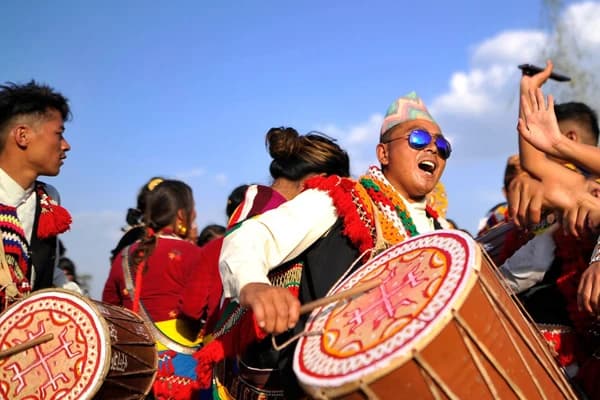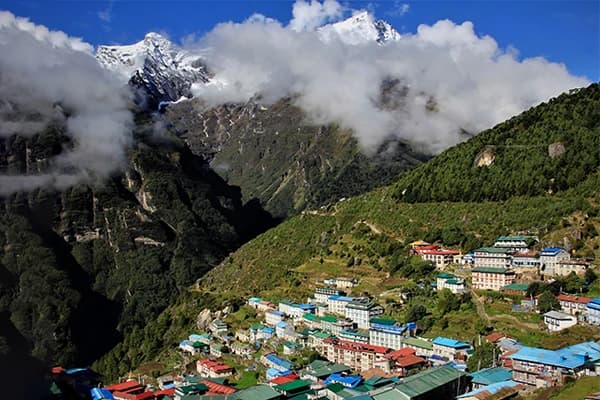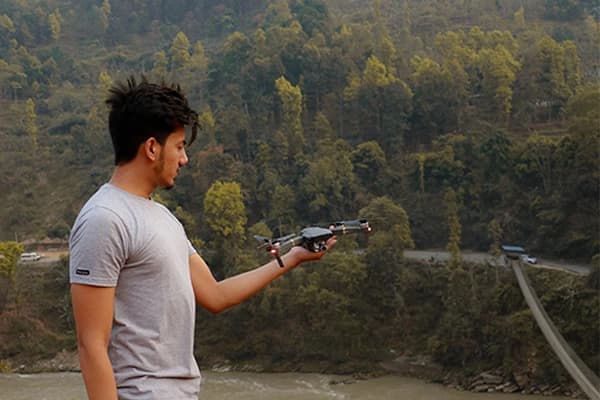Muktinath Temple (Mustang District)
Muktinath Temple is an ancient and one of the most popular sacred sites in Nepal dedicated to the lord Vishnu (lord of liberation). It is located in the Mustang district at an altitude of 3,710 meters (12,172 feet). This site is popular among both Hindus and Buddhists.
Key attractions of the pilgrimage site
- It is built in pagoda-style architecture, featuring the golden pinnacle and prayer flags.
- The temple compound has 108 cow face-shaped water spouts.
- Near the main temple, there is Jwala Mai Temple, known for the eternal natural gas flames burning continuously from the rock formations.
- The temple complex features Tibetan-style monasteries such as Samba Gompa and Narshing Gompa dedicated to the deities like Guru Rimpoche and Shakyamuni.
- There are other sacred sites within the temple complex, including Vishnu Paduka, Mukteshwar Mahadev Temple (a Shakti Peetha), and Paap Kunda and Punya Kunda ponds connected to the 108 water spouts.
- Breathtaking views of the snow-capped peaks like the Dhaulagiri, Nilgiri, annapurna, Manasalu, and machapuchare mountains within the temple premises.
Muktinath Temple is seen as a place of moksha and one of the 108 Divya Desams by Hindus. Buddhists see the temple as a Chumig Gyatsa (linked to Guru Rinpoche and tantric practices). These faiths and beliefs symbolize religious harmony.
Every year a large number of visitors perform ritual baths under 108 water sprouts. They believe that if bathed under the water, sprouts purify their soul, wash away all their sins, and get moksha from the cycle of rebirth.
Pashupatinath Temple (Kathmandu)
Pashupatinath Temple is a popular site located in Kathmandu, Nepal, at an altitude level of 1317 meters (4,320 feet). It is also a unesco world heritage site dedicated to the lord Shiva in his form as Pashupati. It serves as a center for daily worship, grand festivals, and traditional cremation rituals along the riverbanks.
Key attractions of the pilgrimage site
- It is built in the traditional Newari pagoda style, featuring two copper roofs plated with gold and a golden spire at the top.
- The temple has four main doors, each covered with silver sheets.
- The wooden beams of the doors are intricately carved with the holy figures.
- The temple complex includes over 500 smaller shrines and temples dedicated to various Hindu deities.
- The complex features a giant bronze statue of Nandi (Shiva’s bull).
- It houses a unique stone Mukhalinga with a silver yoni base, featuring four faces representing different aspects of Shiva.
- The temple area includes Arya Ghat, where cremation ceremonies are conducted.
- The temple is located on the banks of the Bagmati River (considered a holy river).
The origins of the Pashupatinath temple can be dated back to the pre-Vedic period. Some legends also say that the temple's earliest structures were built around the 5th century CE by King Prachanda Dev of the Licchavi dynasty.
The festivals celebrated here are Maha Shivaratri, Teej, Haribodhana Ekadashi, and so on. The larger number of crowds comes during the maha shivaratri and teej festivals. That is the reason it is in the top 10 most revered pilgrimage sites in Nepal.
Manakamana Temple (Gorkha District)
Manakamana Temple is a prominent Hindu temple located in Kafakdada Hill of the Gorkha District of Nepal at an elevation of about 1,300 meters. It is dedicated to the Goddess Manakamana (incarnation of Bhagwati (Parvati). It was established in the 17th century during the reign of King Ram Shah of Gorkha.
Key attractions of the pilgrimage site
- The main sanctum houses the goddess in the form of a shila (sacred stone), with adjacent boulders representing other deities such as Bhairab, Ganesh, Kumari, and Betaal.
- The temple features a traditional Nepalese pagoda style, with multi-tiered roofs and intricate wooden carvings depicting deities and mythological motifs.
- The structure of the temple combines stone and wood.
- The courtyard of the temple is surrounded by multiple shrines.
- The temple is accessible via the thrilling cable car ride.
- The temple offers stunning views of the Annapurna, Manaslu, and Himchuli.
- It is surrounded by the beautiful hills, lush green forests, terraced fields, and the Trishuli River valley.
- Rituals and offerings are performed daily.
- The nearby attractions include Gorkha Palace, Siddha Gufa, Bandipur, and Trishuli River.
The Manakamana temple is also a popular pilgrimage site in Nepal. It is linked to a legend of a queen with divine powers. After the queen’s death, a miraculous stone was found on the farm. It led her priest, Lakhan Thapa, to build a shrine.
The temple hosts several festivals like dashain, Panchami, Nag Panchami, and so on. It is believed that visiting the temple on these occasions, all the heartfelt wishes of devotees will be fulfilled.
Boudhanath Stupa (Kathmandu)
Boudhanath Stupa (Kathmandu), also known as Boudha Stupa, Khasti Chaitya, or Jarung Kashor, is an important Buddhist temple in Kathmandu, Nepal. It represents the Buddhist cosmology and serves as a focal point for Tibetan Buddhism and pilgrimage in Nepal.
Key attractions of the pilgrimage site
- The stupa has a whitewashed dome and gilded tower topped with the iconic all-seeing eyes of the Buddha and a 13-tiered spire.
- The stupa’s designs feature the plinth (which represents earth), the dome (which represents water), the harmika (which represents fire), the spire (which represents air), and the umbrella (which represents void or ether).
- The 108 images of the Dhyani Buddha Amitabha and a ring of prayer wheels set into 147 niches surround the base of the stupa.
- In stupas, daily rituals, prayers, and circumambulations (koras) are performed.
- The whole environment around the stupa is peaceful and filled with spiritual energy.
The stupa dates back to the Lichhavi period (4th–6th century CE). It is also believed that shortly after the death of buddha, this site was constructed. After 2959, many Tibetan refugees settled around the stupa, which led to the establishment of over 50 gompas (monasteries) and a vibrant Tibetan community nearby.
The major festivals that are celebrated in the Boudhanath stupa are Buddha Jayanti, losar (Tibetan New Year), Mamla Jatra (Boudha Ajima Jatra), Ropai Jatra & Gai Jatra, Chechyu Puja, Temal Jatra, and so on.
Gosainkunda Lake (Rasuwa District)
Gosaikunda Lake is a sacred alpine lake located in the Langtang National Park of Rasuwa District, Nepal, at an elevation of 4,380 meters. Devotees visit the lake to take a holy dip in its icy waters and cleanse their sins.
Key attractions of the pilgrimage site
- It has a surface area of about 13.8 hectares (34 acres).
- The lake complex includes a cluster of at least 108 interconnected lakes and ponds.
- It is part of the Langtang National Park and supports endangered and vulnerable species of flora and fauna.
- It offers the breathtaking views of the Langtang and Ganesh Himal ranges.
- The lake remains frozen for about six months during winter.
- There is a large rock in the lake believed to be a Shiva shrines.
There is rich history regarding the creation of the lakes. According to the legend, Lord Shiva created the lake by thrusting his trident (trishul) into the mountain to extract water. The extracted water cooled his throat after consuming poison during the cosmic churning of the ocean.
Visitors and pilgrims visit the lakes on several special occasions like janai purnima (Sacred Thread Festival), Shivaratri, Gangadashahara, and so on.
Tengboche Monastery (Khumbu Region)
Tengboche Monastery is one of the most revered pilgrimage sites in Nepal, especially in the Everest region. It is the largest monastery in the Khumbu region, located at an elevation of 3,867 meters. The monastery carries the spiritual heritage of the Sherpa people and Tibetan Buddhism.
Key attractions of the pilgrimage site
- It offers spectacular views of the snow-capped peaks like mount everest, Lhotse, Tawache, Tham Serku, and ama dablam.
- It is surrounded by the Sagarmatha National Park.
- The main structure features a three-story stone and wood building with intricate carvings, murals, and religious motifs.
- It houses a large prayer hall (Dukhang) with towering statues, including a 20-foot statue of Buddha Shakyamuni and statues of Guru Rinpoche and Padmasambhava.
- The walls of the monastery are adorned with exquisite murals depicting Buddha’s life and Buddhist teachings.
- The monastery contains valuable religious art such as thangkas (painted or embroidered Buddhist scrolls), scriptures, ceremonial items, and vibrant murals.
- It is surrounded by the mani stone walls inscribed with sacred Buddhist mantras and colorful prayer flags.
The Tengboche monastery was founded by the Lama Gulu with the blessing of Ngawang Tenzin Norbu. With the support of the three influential Sherpa patrons, notably Karma, a tax collector with connections to Nepal’s Rana rulers, the monastery was built.
The most popular festival hosted by the Tengboche monastery is the Mani Rimdu festival, which highlights the Sherpa Buddhist traditions. There are other religious festivals like Dashain and tihar that are celebrated here, which place the monastery among 10 religious places of Nepal.
Swayambhunath Stupa (Kathmandu)
Swayambhunath stupa is one of the most popular and oldest pilgrimage sites located in the Kathmandu Valley of Nepal. The stupa features a white domed infrastructure that depicts Kathmandu's rich historical and architectural artisans.
Key attractions of the pilgrimage site
- The large white domed stupa is topped with a gilded spire about 43 meters high.
- It features all-seeing eyes of Buddha painted on all four sides of the cube-shaped structure.
- The stupa’s architecture combines a hemisphere (dome), cuboid (base), and pyramid (spire).
- It offers panoramic views of Kathmandu city and the surrounding Himalayan mountains.
- The base of the stupa is surrounded by the prayer wheels inscribed with the mantra “om mani padme hum.”
- There are thousands of colorful prayer flags fluttering above the sites.
- There are statues of the five Dhyani Buddhas, and they are displayed around the stupa.
- The surrounding attractions include Harati Temple, Anantapur Temple, and Pratappur Temple.
The pilgrims and visitors often climb the 365 steep stone steps to reach the stupa. There are minor roads also available, but visitors seem to enjoy the journey. When reached at the top, they perform rituals such as spinning prayer wheels, lighting butter lamps, offering flowers, and circumambulating the stupa in a clockwise direction while chanting prayers.
This site hosts festivals like buddha jayanti (Buddha Purnima), Gunla Parva (Gunla Festival), sonam lhosar, indra jatra, Shree Panchami, and so on. Both Hindus and Buddhists visit and worship the deities on several occasions.
Bhimeshwar Temple (Dolakha District)
Bhimeshwar Temple, also known as Dolakha Bhimsen, is an ancient Hindu temple located in the Bhimeshwar Municipality of Dolakha District, Nepal. It is dedicated to the God Bhimsen (patron deity of trade, commerce, and fortune). The elevation level of the temple is 1,554 meters.
Key attractions of the pilgrimage site
- The temple is roofless at the center.
- The main idol inside the temple is a roughly hewn, triangular-shaped stone known as Bhindyo.
- It offers the beautiful views of the Tamakoshi River and terraced farms.
- It lies in the lap of Mt. Gaurishankar.
- The temple showcases the traditional Newari art, including woodcrafts, sketches, and numerous statues and bells.
- The complex includes images of Draupadi (wife of the Pandavas), Kunti (mother of the Pandavas), and elements typical of Shiva worship, such as a lingam entwined with gilded snakes
Legends say that during the exile, the Bhima, a powerful Pandava prince, is said to have spent a year in Dolakha. There is also a story that the triangular stone is the manifestation of the Bhimsen. The fact is the idol has been seen sweating before the disaster in Nepal.
Furthermore, there are several festivals like Bhima Ekadashi, Bala Chaturdashi, Ram Navami, chaitra ashtami, Janai Purnima, and so on. Due to this, it is one of Nepal's most revered pilgrimage sites.
Lumbini (Kapilvastu District)
Lumbini is one of the most revered sites located in the the Rupandehi District of Nepal. It is the birthplace of Gautam Buddha (founder of Buddhism). The site is located at an altitude level of 150 m above sea level. Lumbini holds immense religious importance in Nepalese society.
Key attractions of the pilgrimage site
- It features the most sacred site in Kapilvastu, Maya Devi Temple, believed to be the exact birthplace of Gautam Buddha.
- It is home to the ancient pillar erected by Emperor Ashoka in the 3rd century BCE.
- A white pagoda with a golden Buddha statue named World Peace Pagoda (Japan Peace Stupa) is also here.
- The area also hosts numerous monasteries that represent Theravada, Mahayana, and Vajrayana traditions.
- There is a museum named the Lumbini Museum that features the Buddha's exhibits, photographs, and artifacts across three galleries.
- The Lumbini crane sanctuary is also a popular attraction that is home to endangered Sarus cranes and other bird species, ideal for bird watching and nature walks.
- The complex features the Myanmar Golden Temple, which has Burmese-style architecture and prayer halls, including the Lokamani Pula pagoda, resembling the famous Shwe-dagon pagoda of Yangon.
- Outside of the main complex, there is the Dharma Swami Maharaja Buddha Vihar Monastery, known for its murals.
Lumbini is one of the four holiest sites in Buddhism alongside Bodh Gaya, Sarnath, and Kushinagar. Pilgrims as well as tourists visit Lumbini to meditate, learn about the meaning of life, spiritual heritage, and rich architectural heritage. It makes this site one of the popular Buddhist pilgrimage sites in Nepal to visit.
Swargadwari (Pyuthan District)
Swargadwari is a popular Hindu pilgrimage site located in Pyuthan District of Lumbini Province, Nepal. The elevation level at which the site sits is approximately 2,100 meters (6,890 feet). It is dedicated to the deities Narayan (Vishnu) and Shiva.
Key attractions of the pilgrimage site
- The temple features shrines related to the deities like Lord Krishna (an incarnation of Vishnu), Shiva, and other Hindu deities.
- The temple complex features an ashram where devotees and monks live, perform rituals, and maintain the traditions established by Guru Maharaj.
- It has a continuously burning holy fire (havan), believed to have been lit over 120 years ago.
- You can observe the daily rituals using ghee and wood and the tradition of distributing sacred ash to pilgrims.
- From the site, you can enjoy the stunning views of the Dhaulagiri Himalayan Range, Dang Valley, Jhimruk, and Madi Valleys.
- The surrounding area is home to the dense forests, rhododendron flowers, and serene landscapes.
- There are large herds of cows that reside in the shelter near the temple, which is also one of the popular attractions.
- You can take part in the rituals, prayers, and communal gatherings.
It is believed that Swargadwari is the place where the five Pandavas from the Mahabharata worshipped Lord Mahadev for the last time before their ascent to heaven during the Dwapara Yuga. It is one of the most revered pilgrimage sites also because it is a sanctuary for cows, which are highly respected in Hinduism.
The popular festivals that are celebrated here are Kartik Purnima, Baisakh Purnima, and other festivals like Dashain, Tihar, and so on. You can plan your journey to experience the festive atmosphere along with the other attractions.
Travel Tips
- Respect the locals, the local customs, and the cultures.
- Always ask permission before taking photographs of a person or the religious ceremonies.
- Carry the filtered water, as the tap water may generally not be safe to drink.
- Wear comfortable walking shoes, as many sites require walking or climbing steps.
- Bring sun protection, especially for high-altitude sites like Muktinath and Gosainkunda.
- Follow the lead of the devotee if unsure about the rituals.
- Bring or buy the customary offerings, such as flowers, incense, or fruits.
- Hire a local guide to enhance your experience.
- Try to combine your journey with the festival dates for more cultural immersion and festive atmosphere experiences.
- Interact with the locals and gain insights about the cultures firsthand.
- Choose the best season, like spring or autumn, for the pilgrimage hikes.
- Wear modest clothes while visiting the temples and monasteries.
Conclusion
In short, the top 10 most revered pilgrimage sites in Nepal offer profound spiritual journeys, blending ancient rituals, breathtaking natural beauty, and opportunities for deep personal transformation. You can connect with the divine in each sacred destination, reflect on the life mysteries, and experience a sense of renewal.
Walk the sacred path — we’ll help you create your custom spiritual journey in Nepal.





